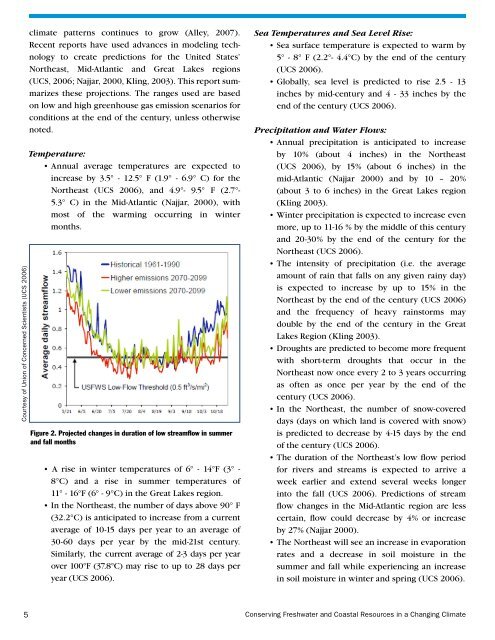Conserving Freshwater and Coastal Resources in a Changing Climate
Conserving Freshwater and Coastal Resources in a Changing Climate
Conserving Freshwater and Coastal Resources in a Changing Climate
Create successful ePaper yourself
Turn your PDF publications into a flip-book with our unique Google optimized e-Paper software.
Courtesy of Union of Concerned Scientists (UCS 2006)<br />
climate patterns cont<strong>in</strong>ues to grow (Alley, 2007).<br />
Recent reports have used advances <strong>in</strong> model<strong>in</strong>g technology<br />
to create predictions for the United States’<br />
Northeast, Mid-Atlantic <strong>and</strong> Great Lakes regions<br />
(UCS, 2006; Najjar, 2000, Kl<strong>in</strong>g, 2003). This report summarizes<br />
these projections. The ranges used are based<br />
on low <strong>and</strong> high greenhouse gas emission scenarios for<br />
conditions at the end of the century, unless otherwise<br />
noted.<br />
Temperature:<br />
• Annual average temperatures are expected to<br />
<strong>in</strong>crease by 3.5° - 12.5° F (1.9° - 6.9° C) for the<br />
Northeast (UCS 2006), <strong>and</strong> 4.9°- 9.5° F (2.7°-<br />
5.3° C) <strong>in</strong> the Mid-Atlantic (Najjar, 2000), with<br />
most of the warm<strong>in</strong>g occurr<strong>in</strong>g <strong>in</strong> w<strong>in</strong>ter<br />
months.<br />
Figure 2. Projected changes <strong>in</strong> duration of low streamflow <strong>in</strong> summer<br />
<strong>and</strong> fall months<br />
• A rise <strong>in</strong> w<strong>in</strong>ter temperatures of 6° - 14°F (3° -<br />
8°C) <strong>and</strong> a rise <strong>in</strong> summer temperatures of<br />
11° - 16°F (6° - 9°C) <strong>in</strong> the Great Lakes region.<br />
• In the Northeast, the number of days above 90° F<br />
(32.2°C) is anticipated to <strong>in</strong>crease from a current<br />
average of 10-15 days per year to an average of<br />
30-60 days per year by the mid-21st century.<br />
Similarly, the current average of 2-3 days per year<br />
over 100°F (37.8°C) may rise to up to 28 days per<br />
year (UCS 2006).<br />
Sea Temperatures <strong>and</strong> Sea Level Rise:<br />
• Sea surface temperature is expected to warm by<br />
5° - 8° F (2.2°- 4.4°C) by the end of the century<br />
(UCS 2006).<br />
• Globally, sea level is predicted to rise 2.5 - 13<br />
<strong>in</strong>ches by mid-century <strong>and</strong> 4 - 33 <strong>in</strong>ches by the<br />
end of the century (UCS 2006).<br />
Precipitation <strong>and</strong> Water Flows:<br />
• Annual precipitation is anticipated to <strong>in</strong>crease<br />
by 10% (about 4 <strong>in</strong>ches) <strong>in</strong> the Northeast<br />
(UCS 2006), by 15% (about 6 <strong>in</strong>ches) <strong>in</strong> the<br />
mid-Atlantic (Najjar 2000) <strong>and</strong> by 10 – 20%<br />
(about 3 to 6 <strong>in</strong>ches) <strong>in</strong> the Great Lakes region<br />
(Kl<strong>in</strong>g 2003).<br />
• W<strong>in</strong>ter precipitation is expected to <strong>in</strong>crease even<br />
more, up to 11-16 % by the middle of this century<br />
<strong>and</strong> 20-30% by the end of the century for the<br />
Northeast (UCS 2006).<br />
• The <strong>in</strong>tensity of precipitation (i.e. the average<br />
amount of ra<strong>in</strong> that falls on any given ra<strong>in</strong>y day)<br />
is expected to <strong>in</strong>crease by up to 15% <strong>in</strong> the<br />
Northeast by the end of the century (UCS 2006)<br />
<strong>and</strong> the frequency of heavy ra<strong>in</strong>storms may<br />
double by the end of the century <strong>in</strong> the Great<br />
Lakes Region (Kl<strong>in</strong>g 2003).<br />
• Droughts are predicted to become more frequent<br />
with short-term droughts that occur <strong>in</strong> the<br />
Northeast now once every 2 to 3 years occurr<strong>in</strong>g<br />
as often as once per year by the end of the<br />
century (UCS 2006).<br />
• In the Northeast, the number of snow-covered<br />
days (days on which l<strong>and</strong> is covered with snow)<br />
is predicted to decrease by 4-15 days by the end<br />
of the century (UCS 2006).<br />
• The duration of the Northeast’s low flow period<br />
for rivers <strong>and</strong> streams is expected to arrive a<br />
week earlier <strong>and</strong> extend several weeks longer<br />
<strong>in</strong>to the fall (UCS 2006). Predictions of stream<br />
flow changes <strong>in</strong> the Mid-Atlantic region are less<br />
certa<strong>in</strong>, flow could decrease by 4% or <strong>in</strong>crease<br />
by 27% (Najjar 2000).<br />
• The Northeast will see an <strong>in</strong>crease <strong>in</strong> evaporation<br />
rates <strong>and</strong> a decrease <strong>in</strong> soil moisture <strong>in</strong> the<br />
summer <strong>and</strong> fall while experienc<strong>in</strong>g an <strong>in</strong>crease<br />
<strong>in</strong> soil moisture <strong>in</strong> w<strong>in</strong>ter <strong>and</strong> spr<strong>in</strong>g (UCS 2006).<br />
5<br />
<strong>Conserv<strong>in</strong>g</strong> <strong>Freshwater</strong> <strong>and</strong> <strong>Coastal</strong> <strong>Resources</strong> <strong>in</strong> a Chang<strong>in</strong>g <strong>Climate</strong>

















